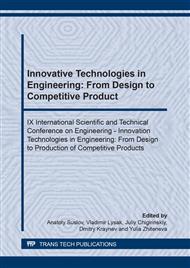[1]
H. Takayama, H. Sekiguchi, H. Takada, One solution for chip hazard in turning - study on automatic programming for numerically controlled machines (Report 1), JSPE, 36:2 (1970) 150-156.
Google Scholar
[2]
I.S. Jawahir, An experimental and theoretical study of the effects of tool restricted contact on chip breaking: A PhD thesis, University of New South Wales, (1986).
Google Scholar
[3]
B. Worthington, M.H. Rahman, Predicting breaking with groove-type breakers, // International Journal of Machine Tool Design and Research, 19 (1979) 121-132.
DOI: 10.1016/0020-7357(79)90002-7
Google Scholar
[4]
M.I. Sadik, B. Lindstrom, A simple concept to achieve a rational chip form, // Journal of Materials Processing Technology, 54 (1995) 12-16.
DOI: 10.1016/0924-0136(95)01911-1
Google Scholar
[5]
J. Shinozuka, T. Obikawa, T. Shirakashi, Chip breaking analysis from the view point of the optimum cutting tool geometry design, Journal of Materials Processing Technology, 62 (1996) 345-351.
DOI: 10.1016/s0924-0136(96)02433-8
Google Scholar
[6]
S.M. Athavale, J.S. Strenkowski, Material damage based model for predicting chip breakability, Journal of Manufacturing Science and Engineering, 119 (1997) 675-680.
DOI: 10.1115/1.2836808
Google Scholar
[7]
I.Z. Zhang, I. Peklenik, Chip curl, chip breaking and chip control of the difficult-to-cut materials, Ann. CIRP, 1 (1980) 79-84.
DOI: 10.1016/s0007-8506(07)61299-2
Google Scholar
[8]
W. Grzesik, E. Kwiatkowska, An energy approach to chip breaking when machining with grooved tool inserts, International Journal of Machine Tools and Manufacture, 37:5 (1997) 569-577.
DOI: 10.1016/s0890-6955(96)00076-4
Google Scholar
[9]
Y.M. Lee, S.H. Yang, S.I. Chang, Assessment of chip-breaking characteristics using new chip-breaking index, Journal of Materials Processing Technology, 173 (2006) 166-171.
DOI: 10.1016/j.jmatprotec.2005.05.057
Google Scholar
[10]
A.K. Balaji et al., Performance-Based Predictive Models and Optimization Methods for Turning Operations and Applications: Part 2, Assessment of Chip Forms and Chip Breakability, Journal of Manufacturing Processes, 8:2 (2006) 144-158.
DOI: 10.1016/s1526-6125(06)80009-5
Google Scholar
[11]
S. Mikhailov, Modelling and optimization of the chip forming process during material cutting operations: a monograph, Kostroma: Kostroma State Technical University, 2005, p.180.
Google Scholar


